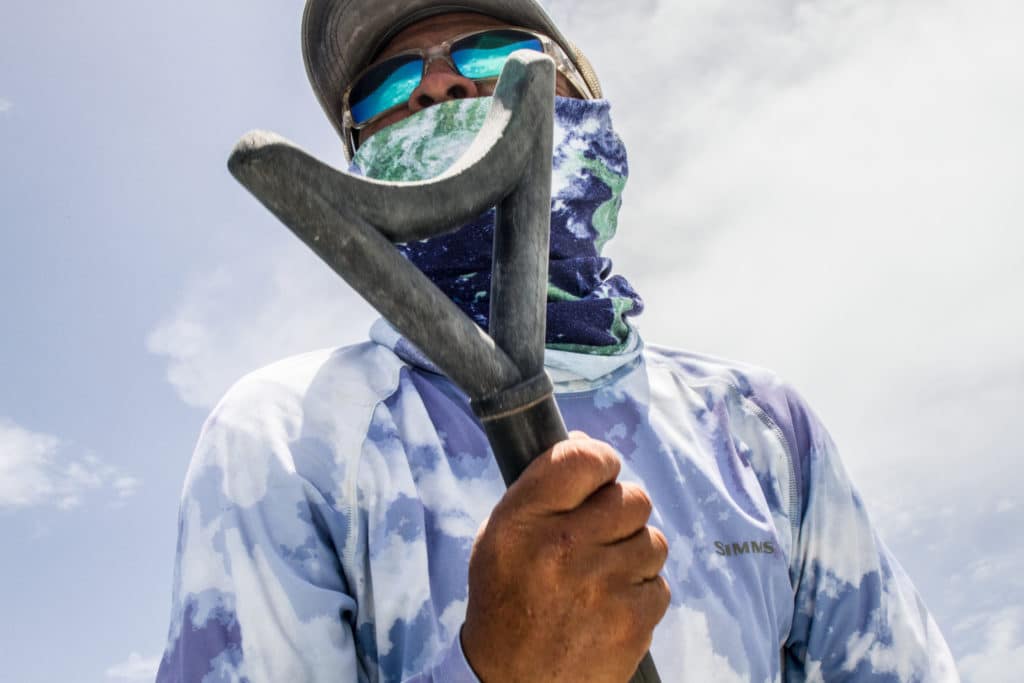
First-time charter clients often step aboard my flats boat and ask why I don’t have a trolling motor. “Because I know that will always start,” I tell them, pointing at my 22-foot push pole. Trolling motors are more dependable than ever, but in the shallow depths I typically target, a flats boat push pole is still the best tool when stalking wary fish.
“Poling is all about being quiet,” says Capt. Scott Sommerlatte, a 22-year veteran guide on the Texas coast from Matagorda to Rockport. He normally fishes in water five inches to two feet deep and spends up to 12 hours a day poling his 18-foot skiff. “A pole flopping around and splashing will send fish packing,” he says. “That’s why you should buy the lightest pole you can afford.”
There are several materials used to make fishing push poles, from aluminum to fiberglass to carbon fiber. Prices range from under $200 to more than $1,500, depending on materials and length. Graphite push poles or carbon-fiber push poles are extremely light, stiff and the most expensive. Fiberglass push poles are more affordable yet weigh more. Selecting the right pole depends on budget, obviously, but also application and use.
Push Pole Materials
“Fiberglass push poles are fine for novice users or those who won’t be poling very much,” explains Kevin Shaw, owner of Stiffy in Corpus Christi, Texas. “Here in Texas, boaters have the option of a paddle or push pole for their required safety gear, so the 10-foot fiberglass poles are our biggest seller. A guy in a 22-foot bay boat isn’t going to pole too often, but he can use it to push off an oyster bar or fend off a dock. Our Hybrid model is our most popular. It’s 80 percent graphite with 20 percent glass wrap for an abuse factor. And we build three graphite models, including the ultimate technical pole, the Graphite Extreme. It’s made from HR40 high-modulus graphite with unidirectional weave. We designed that pole for professional guides who are on the platform all day long.”
The Right Size Push Pole
Choosing the right length is another factor when buying a push pole. Variables such as the height of poling platforms or towers, along with the normal depth and bottom composition of the water fished, should be considered. If a boat is equipped with a platform, 18 to 20 feet is the minimum recommended length for depths less than five feet. Soft mud and deeper water necessitate longer poles. The longer the pole, the more the poler can “walk” the pole down without repositioning. In other words, more hand-over-hand movement with a single plant means more propulsion with less effort. Less effort means less fatigue and noise, which equals more fish.
“Generally I tell customers to take the boat length, add 3 feet and then tweak for specific fishing conditions,” says Joe Welbourn, owner of Carbon Marine. The company builds carbon-fiber push poles using sections and ferrules that are factory-assembled for customers in Florida. Clients in other states are shipped the pieces and epoxy adhesive to reduce the high freight costs of shipping a one-piece pole.
“In the past, sectional poles often leaked or broke at the joints because the end-user didn’t know how or failed to properly put the pole together,” Welbourn explains. “We build our components to very tight tolerances and include detailed assembly instructions if the pole isn’t assembled by the factory. Assembly takes about 15 minutes, and all the epoxy is pre-measured to make everything simple.”
Take Care of Your Fishing Push Pole
Because high-modulus graphite is more brittle and less forgiving than fiberglass or composite, both Shaw and Welbourn recommend not staking off with carbon-fiber poles. Staking off involves sticking the pole point into the bottom and then tying the boat to the pole to hold the craft in place. Sommerlatte also cautions that muddy bottoms with broken shell can chip or crack graphite poles, which can lead to breaks. “Most push poles break because of accidents or abuse,” Welbourn says.
Push-pole tips are usually nylon, although some are available with stainless-steel spikes to keep from slipping on hard bottom or coral. Pole feet are mostly nylon as well. Sommerlatte believes the simple Y-fork provides the quietest entry into the water. Triangle-shaped feet or those with a broader base don’t sink in soft mud as much.
Other than the graphite precautions, push-pole maintenance is easy. At the end of the day, rinse it down. Next, relax the pole so it doesn’t take a permanent set or bend. Keep it out of the sunlight to minimize damage from ultraviolet rays. A section of PVC pipe cut to length makes a great storage container for that purpose. When you wax the boat, add a coat to the pole too.
Having the right tool for the right job always makes tasks easier. The same is true with skiff push poles. Carefully considering where and how often you’ll use one assures you’ll enjoy that new tool. Especially when you silently ease into casting range and hook that trophy fish.
Some of the Best Push Pole Companies
Biscayne Rod Co.
One-piece and sectional fiberglass and composite poles up to 22 feet
Cabela’s
High Tide composite 18-foot poles
Carbon Marine
Mangrove and Loop carbon-fiber poles up to 26 feet
Moonlighter
Fiberglass and carbon-fiber poles up to 20 feet
Pole Cat Push Poles
Fiberglass and graphite poles up to 19 feet
Skinnywater Products
Aluminum push poles up to 20 feet
Stiffy
Fiberglass, composite and graphite poles up to 24 feet
Temple Fork Outfitters
Mangrove carbon-fiber poles up to 24 feet
Available through TFO dealers









